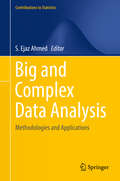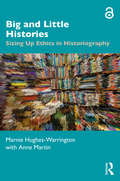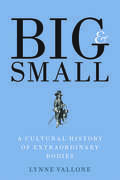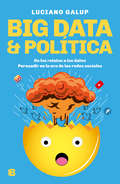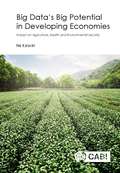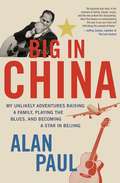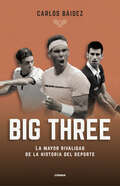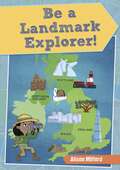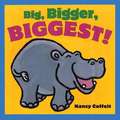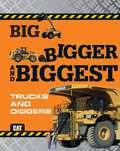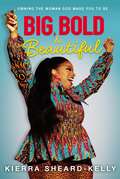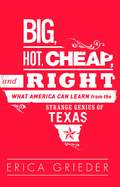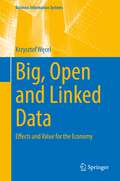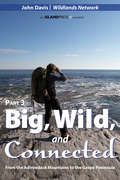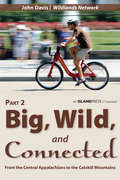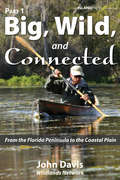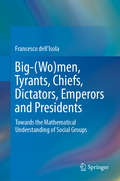- Table View
- List View
Big and Bold Art (Fountas & Pinnell Classroom, Guided Reading)
by Joanna CruzNIMAC-sourced textbook. MAKE ROOM. Most art fits on a wall or inside a room. But not this art. Take a look at art that's so huge, it fills up space the size of soccer fields.
Big and Bright: A History of the McDonald Observatory
by David S. Evans J. Derral MulhollandBy day, every year over 40,000 visitors pour in. Across the Rio Grande, a hundred miles away, Mexican mountaineers use the white domes as landmarks. By night, perched almost 7,000 feet above the sleeping, earthbound world, astronomers probe the secrets of the night sky. This is the University of Texas McDonald Observatory, one of the world's largest university-operated astronomical installations. Big and Bright: A History of the McDonald Observatory is the story of a remarkable collaboration between two major universities, one a prestigious private school, the other a growing southwestern state institution. The University of Chicago had astronomers, but its Yerkes Observatory was aging and underfunded; the University of Texas had money for an observatory but no working astronomer to staff it. Out of their mutual need, they formed a thirty-year compact for a joint venture. Unusual in its day, the Yerkes-McDonald connection presaged the future. In this arrangement, one can see some of the beginnings of today's consortium "big science. " Now the McDonald Observatory's early history can be put in proper perspective. Blessed with a gifted and driving founding director, the world's (then) second-largest telescope, and an isolation that permitted it to be virtually the only major astronomical observatory that continued operations throughout World War II, the staff of McDonald Observatory helped lay the foundations of modern astrophysics during the 1940s. For over a decade after the war, a lonely mountaintop in West Texas was the mecca that drew nearly all the most important astronomers from all over the world. Based on personal reminiscences and archival material, as well as published historical sources, Big and Bright is one of the few histories of a major observatory, unique in its focus on the human side of the story.
Big and Complex Data Analysis: Methodologies and Applications (Contributions to Statistics)
by S. Ejaz AhmedThis volume conveys some of the surprises, puzzles and success stories in high-dimensional and complex data analysis and related fields. Its peer-reviewed contributions showcase recent advances in variable selection, estimation and prediction strategies for a host of useful models, as well as essential new developments in the field. The continued and rapid advancement of modern technology now allows scientists to collect data of increasingly unprecedented size and complexity. Examples include epigenomic data, genomic data, proteomic data, high-resolution image data, high-frequency financial data, functional and longitudinal data, and network data. Simultaneous variable selection and estimation is one of the key statistical problems involved in analyzing such big and complex data. The purpose of this book is to stimulate research and foster interaction between researchers in the area of high-dimensional data analysis. More concretely, its goals are to: 1) highlight and expand the breadth of existing methods in big data and high-dimensional data analysis and their potential for the advancement of both the mathematical and statistical sciences; 2) identify important directions for future research in the theory of regularization methods, in algorithmic development, and in methodologies for different application areas; and 3) facilitate collaboration between theoretical and subject-specific researchers.
Big and Little Histories: Sizing Up Ethics in Historiography
by Anne Martin Marnie Hughes-WarringtonThis book introduces students to ethics in historiography through an exploration of how historians in different times and places have explained how history ought to be written and how those views relate to different understandings of ethics. No two histories are the same. The book argues that this is a good thing because the differences between histories are largely a matter of ethics. Looking to histories made across the world and from ancient times until today, readers are introduced to a wide variety of approaches to the ethics of history, including well-known ethical approaches, such as the virtue ethics of universal historians, and utilitarian approaches to collective biography writing while also discovering new and emerging ideas in the ethics of history. Through these approaches, readers are encouraged to challenge their ideas about whether humans are separate from other living and non-living things and whether machines and animals can write histories. The book looks to the fundamental questions posed about the nature of history making by Indigenous history makers and asks whether the ethics at play in the global variety of histories might be better appreciated in professional codes of conduct and approaches to research ethics management. Opening up the topic of ethics to show how historians might have viewed ethics differently in the past, the book requires no background in ethics or history theory and is open to all of those with an interest in how we think about good histories.
Big and Small, Room for All
by Jo Ellen BogartA captivating look at how a child, fits into the great, big universe around us.“Big sky, big sky, what is bigger than the sky?”In this clever concept book for young readers, award-winning author Jo Ellen Bogart explores the size of animate and inanimate objects and their place in the universe. She introduces children to the concept of “we” — that humans are a big part of the world, but a small part of existence.In the vastness of the universe, with galaxies swirling through space, the book begins with simple words printed on the darkness. Moving closer to our world, we see the solar system, our sun at the center. Closer still, we see the huge ball of fire, which is the sun, and the third planet out from it — our blue Earth. From Earth looming huge on the page, young readers view smaller and smaller objects, from mountain to tree to man to child to kitten to mouse to flea to microscopic beings, amazing in their complexity.Accompanied by artist Gillian Newland’s lavish watercolor paintings, Big and Small, Room for All places the immensity and wonder of space in perspective so young readers comprehend they are part of creation, but a small part of all that exists.
Big and Small: A Cultural History of Extraordinary Bodies
by Lynne ValloneA groundbreaking work that explores human size as a distinctive cultural marker in Western thought Author, scholar, and editor Lynne Vallone has an international reputation in the field of child studies. In this analytical tour-de-force, she explores bodily size difference—particularly unusual bodies, big and small—as an overlooked yet crucial marker that informs human identity and culture. Exploring miniaturism, giganticism, obesity, and the lived experiences of actual big and small people, Vallone boldly addresses the uncomfortable implications of using physical measures to judge normalcy, goodness, gender identity, and beauty. This wide-ranging work surveys the lives and contexts of both real and imagined persons with extraordinary bodies from the seventeenth century to the present day through close examinations of art, literature, folklore, and cultural practices, as well as scientific and pseudo-scientific discourses. Generously illustrated and written in a lively and accessible style, Vallone’s provocative study encourages readers to look with care at extraordinary bodies and the cultures that created, depicted, loved, and dominated them.
Big and Small: Learn about Opposites
by Kunal KunduThis tells us about the difference between an elephant and a mouse, and other extreme differences.
Big as a Giant Snail (The World of Weird Animals)
by Jess KeatingGo big or go home! Meet the biggest weirdos on Earth in this colosally cool collection from the team that brought you Pink Is For Blobfish.It's a big wide world, full of critters that are larger than life! Sure, there are the usual suspects: blue whales, polar bears, elephant seals . . . but others will take you by surprise. The giant snail, for instance, or the ginormous Atlas moth. Like Pink Is for Blobfish and Cute as an Axolotl, Big as a Giant Snail will cover a wide variety of species, while subtly delving into misconceptions and stereotypes associated with size. Best of all? These tall tales are totally true! "Awe-inspiring... This work fits into so many lessons, from endangered species to climate change and habitat preservation, that it&’s hard to imagine a collection that would not benefit from having it on its shelves." —School Library Journal
Big cats: Cheetahs
by Victor Gentle Janet PerryAn introduction to the physical characteristics, behaviour, natural environment, and threats to the survival of the cheetah, considered to be the fastest land animal on Earth.
Big data & Política: De los relatos a los datos. Persuadir en la era de las redes sociales
by Luciano GalupEl primer libro de uno de los analistas de marketing y consultoría con mayor proyección de los últimos años; un análisis pormenorizado de cómo la información se ha convertido en uno de los bienes más valiosos y las redes sociales en el medio esencial para la comunicación política en lo que va del siglo XXI. Vivimos en la era de los datos. Casi toda la actividad humana deja una huella digital que es almacenable y analizable. Los datos y las redes sociales se han convertido en una herramienta clave para la comunicación de nuestras sociedades y también para la orientación del debate público. Una parte cada vez más importante de los recursos de campañas políticas y de gobierno se destinan a las estrategias de análisis de datos y de comunicación digital. También crece el interés de los ciudadanos por el uso de los datos y de las redes sociales como mecanismos de participación y de seducción de voluntades. Casos como el de Cambridge Analytica y Facebook o la popularización de términos como "postverdad" o "noticias falsas" (fake news) amplificaron la difusión y el interés en las estrategias de comunicación política orientadas a redes sociales y la manipulación de información de los usuarios. Luciano Galup, uno de los mayores expertos argentinos en comunicación digital, analiza las transformaciones que estos medios revolucionarios entrañan para la política y para nuestra vida diaria. Explora cómo nos estamos adaptando a un mundo que produce cantidades desproporcionadas de información a velocidades irrefrenables. Estudia cómo se construye un candidato electoral en base a los datos sobre los votantes, en un contexto de fragmentación y microculturas, en el que un político ya no sólo debe saber hablar sino aprender a escuchar; y, a su vez, cómo se garantiza una participación amplia, transparente y genuina de la ciudadanía en el debate público. Y se pregunta, sobre todo, cómo comunicarse más y mejor para devolverle prestigio y credibilidad a la política y a la información, de cara a un mundo nuevo lleno de incertidumbres y grandes posibilidades.
Big data management in Sensing: Applications in AI and IoT
by Renny Fernandez Terrance Frederick FernandezThe book is centrally focused on human computer Interaction and how sensors within small and wide groups of Nano-robots employ Deep Learning for applications in industry. It covers a wide array of topics that are useful for researchers and students to gain knowledge about AI and sensors in nanobots. Furthermore, the book explores Deep Learning approaches to enhance the accuracy of AI systems applied in medical robotics for surgical techniques. Secondly, we plan to explore bio-nano-robotics, which is a field in nano-robotics, that deals with automatic intelligence handling, self-assembly and replication, information processing and programmability.
Big data's big potential in developing economies: impact on agriculture, health and environmental security
by Nir KshetriBig data involves the use of sophisticated analytics to make decisions based on large-scale data inputs. It is set to transform agriculture, environmental protection and healthcare in developing countries. This book critically evaluates the developing big data industry and market in these countries and gives an overview of the determinants, performances and impacts. The book provides a detailed analysis of technology creation, technology infrastructures and human skills to utilize big data in these countries. It discusses novel applications and business models involving big data to overcome healthcare barriers. The book also offers an analysis of big data's potential to improve environmental monitoring and protection. It posits that big data is likely to have far-reaching and profound impacts on the agricultural sector. A key question addressed is also how gains in agricultural productivity associated with big data will benefit smallholder farmers relative to global multinationals in that sector. It also probes big data's roles in the creation of markets that can improve the welfare of smallholder farmers. The book gives special consideration to big data-led transformation of the financial industry and discusses how the transformation can increase small-holder farmers' access to finance by changing the way lenders assess creditworthiness of potential borrowers. It also takes a look at data privacy and security issues facing smallholder farmers and reviews differences in such issues in industrialized and developing countries. The key ideas, concepts and theories presented are explored, illustrated and contrasted through in-depth case studies of developing world-based big data companies and deployment and utilization big data in agriculture, environmental protection and healthcare.
Big in China
by Alan PaulThe inspiring story of a man, a family, a band, a foreign country, and a new beginning When Alan Paul's wife was offered the job as the Wall Street Journal's China bureau chief, he saw it as an amazing opportunity to shake up their increasingly staid suburban New Jersey life. Excited and not a little scared, they packed up their three children-ages two, four, and seven-and headed for adventure and uncertainty in Beijing, China. Based on his award-winning Wall Street Journal Online column, "The Expat Life," Big in China explores Paul's unlikely three-and-a-half-year journey of reinvention in this rapidly developing metropolis. He reveals the challenges that he and his family faced while living in a foreign land, including reaching beyond the expat community, coming to terms with his new role as a stay-at-home dad, and learning to navigate and thrive in an unfamiliar culture. By viewing an intimidating challenge as a golden opportunity rather than as a burden, he saw his world open up around him. At the heart of the memoir is his time fronting Woodie Alan, a blues band he formed with a Chinese partner. The cross-cultural collaboration became an unlikely success. The band embarked on a tour across China, earning the title "Best Band in Beijing" and recording an acclaimed CD of original music sung in both English and Mandarin, which prompted ZZ Top's Billy Gibbons to say, "This is the best Chinese blues band I ever heard. Who knew?" Woodie Alan was symbolic of Paul's entire China experience and?proof of what transpires when one can suspend preconceived notions and plunge into a new reality. A testament to the transformative power of a life lived beyond comfortable borders, Big in China reminds us of the importance of always keeping our horizons wide and our thoughts ambitious.
Big three. La mayor rivalidad de la historia del deporte
by Carlos BáidezBig Three es el único libro que narra la mayor rivalidad deportiva de la historia, la que enfrenta a los tres mejores tenistas de todos los tiempos: Roger Federer, Rafa Nadal y Novak Djokovic. Durante dos décadas, los protagonistas de este libro han dominado con gran autoridad el circuito ATP, disputándose los Grand Slams, las grandes competiciones y el número uno del ranking mundial. En una batalla física y psicológica sin precedentes, han deleitado a los aficionados con duelos inolvidables que será difícil que volvamos a vivir. Carlos Báidez analiza en Big Three los entresijos de la ya legendaria rivalidad de los tres mayores genios de la raqueta. Un recorrido detallado desde su infancia hasta su lucha actual por ser el mejor tenista de siempre. En el camino, nos muestra el rostro más humano de Federer, Nadal y Djokovic, además de permitirnos revivir sus momentos de mayor gloria y sus derrotas más sonadas.Una obra imprescindible para cualquier aficionado al deporte, que aporta innumerables argumentos y datos para que el lector pueda decidir quién es, en su opinión, el mejor tenista de la historia. La crítica ha dicho:«Lectura obligada.»Conrado Valle, periodista «Báidez aporta gran cantidad de información desde un punto de vista novedoso: el de analizar a cada uno de ellos en relación con los otros dos para que el lector opine quién es el mejor de la historia. También para que sea consciente de la excepcionalidad de haber vivido y disfrutado de unos años estelares.»Pedro Zuazua, El País«Federer, Nadal y Djokovic frente a frente, para admirar esta rivalidad prolongada en el tiempo. Librazo de Carlos Báidez. ¿A qué esperáis para disfrutar de esta joya?»Deporte y libros «Quería ampliar la perspectiva que los aficionados tienen sobre los tres jugadores y lo he hecho entrecruzando sus vidas, como si se tratara de una película.»Entrevista a Carlos Báidez en La SER«Detalla con rigurosidad y precisión de cirujano, y apoyado en datos estadísticos, los logros de cada uno de estos fenómenos: Roger Federer, Rafa Nadal y Novak Djokovic. Comparándolos entre ellos desde sus inicios en la infancia. Y siempre dando al lector la oportunidad de hacer su elección, o decantarse por uno según sus filias y sus fobias.»Las lecturas de Oscar «Recomendadísimo.Con una ilustración maravillosa y que te atrapa de principio a fin. ¡Todos a comprarlo ya mismo!»José Morón, redactor jefe de Punto de Break «Carlos Báidez recorre la vida de los tres desde sus inicios y aporta datos novedosos sobre estas leyendas.»Marca
Big, Bigger, Biggest!
by Nancy CoffeltI'm big. I'm bigger. I'M BIGGEST. How would you describe a hippopotamus? Big might be the first word that comes to mind. What about a whale? Gigantic? Immense? How about enormous! What if you had to find a word for the biggest animal of them all--a dinosaur. Mammoth? Humongous? Colossal! With bright pictures of animals in all shapes aid sizes, this terrific read-aloud introduces young children to the language of comparisons, synonyms, and antonyms.
Big, Bigger, and Biggest Trucks and Diggers
by CaterpillarReaders will get to know different kinds of Caterpillar trucks and diggers, from the smallest to the biggest! Twelve of the most impressive machines are shown in order of size, with full-color photos and fascinating facts for each one. Plus, this is the fixed format version, which will look almost identical to the print version.
Big, Bold, and Beautiful: Owning the Woman God Made You to Be
by Kierra Sheard-KellyIn this immersive and inspirational book, Grammy Award-nominated singer Kierra Sheard shares her hard-won advice on body positivity, spiritual self-care, goal setting, finding your joy, and living boldly in faith, empowering you to grab the life you&’re meant to lead.Every one of us was born to make a difference. But do you sometimes feel overwhelmed by the things the world prioritizes, thinking you don&’t match up or you don&’t fit into the mold? Or do you wish you had a more supportive family, or positive role models, or access to the things you need emotionally and spiritually to keep going? Kierra Sheard sees you and will teach you how to:Identify your goals, talents, and gifts so you can survive and thriveDeal with societal expectations and focus on what really mattersTruly love yourself and find out who you really are as an individualLive your faith loud and proudInside Big, Bold, and Beautiful you&’ll find:Short and easy-to-read chapters with deep advice for teens and young women on navigating life, and insightful questions to help you find your pathIllustrated feature pages containing stand-alone graphics that highlight key topics for easy reference when you need a boostAn ideal gift for those who need encouragement, as well as graduates getting ready for a new phase
Big, Hot, Cheap, and Right: What America Can Learn from the Strange Genius of Texas
by Erica GriederTexas may well be America's most controversial state. Evangelicals dominate the halls of power, millions of its people live in poverty, and its death row is the busiest in the country. Skeptical outsiders have found much to be offended by in the state's politics and attitude. And yet, according to journalist (and Texan) Erica Grieder, the United States has a great deal to learn from Texas.In Big, Hot, Cheap, and Right, Grieder traces the political history of a state that was always larger than life. From its rowdy beginnings, Texas has combined a long-standing suspicion of government intrusion with a passion for business. Looking to the present, Greider assesses the unique mix of policies on issues like immigration, debt, taxes, regulation, and energy, which together have sparked a bonafide Texas Miracle of job growth. While acknowledging that it still has plenty of twenty-first-century problems to face, she finds in Texas a model of governance whose power has been drastically underestimated. Her book is a fascinating exploration of America's underrated powerhouse.
Big, Open and Linked Data: Effects and Value for the Economy (Business Information Systems)
by Krzysztof WęcelThis book examines the recent evolution of the concept of data as an economic and managerial phenomenon. The author first describes and discusses open data and then introduces the concept of linked data, with a focus on assets for reuse. Furthermore, he addresses the main challenges of big data. Value is identified as the main incentive for the adoption of linked data; accordingly, the next two chapters study sources of data value from a macroeconomic and micro economic perspective, respectively. This contributes to the systematization of important issues at the crossroads of enterprise data and data sharing: data ownership, personal data, and data privacy. In turn, the book reveals the role of innovation as a main vehicle for creating value by unifying big, open, and linked data. It studies the ways in which value can be created, transferred, and captured in the form of business models, before the closing chapter verifies the data unification model by combining open and linked geographical data with big data from a major telecom company.
Big, Wild, and Connected: From the Adirondack Mountains to the Gaspé Peninsula (Island Press E-ssentials)
by John Davis Wildlands NetworkThis E-ssential is a three-part series that covers John Davis's epic journey from Florida to Maine. In 2011, with support from the Wildlands Network, Davis traveled 7,600 miles in 10 months from Florida to Maine by foot, bicycle, skis, and canoe/kayak. His extensive traveles were motivated by wanting to answer the question "Is it possible in the twenty-first century to identify and protect a continental-long wildlife corridor that could help to protect eastern nature into the future?" John paints a vivid picture of the physical challenges of the trek, such as climbing the highest point in South Carolina with a heavily loaded bike and trying to consume the 8,000 calories per day he needed to fuel himself for the journey. As readers adventure with Davis, they will also share his evolving understanding of what it would take to implement an Eastern Wildway. Eastern wildlife, both seen and unseen, from Florida panthers to North Carolina's red wolves to the ghosts of cougars farther north, are the real focus of this adventure as John explores how such wildness can coexist with human development in the most populated regions of the United States. The science and conservation of large-scale connectivity are brought to life by his travels--offering unique insights into the challenges and opportunities for creating an Eastern Wildway. This is a must-read for enthusiasts of hiking narratives, as well as professionals and students interested in issues related to large-scale connectivity. Compelling photographs and other graphics complement John's fascinating story.
Big, Wild, and Connected: From the Central Appalachians to the Catskill Mountains (Island Press E-ssentials)
by John Davis Wildlands NetworkThis E-ssential is a three-part series that covers John Davis's epic journey from Florida to Maine. In 2011, with support from the Wildlands Network, Davis traveled 7,600 miles in 10 months from Florida to Maine by foot, bicycle, skis, and canoe/kayak. His extensive travels were motivated by wanting to answer the question "Is it possible in the twenty-first century to identify and protect a continental-long wildlife corridor that could help to protect eastern nature into the future?" John paints a vivid picture of the physical challenges of the trek, such as climbing the highest point in South Carolina with a heavily loaded bike and trying to consume the 8,000 calories per day he needed to fuel himself for the journey. As readers adventure with Davis, they will also share his evolving understanding of what it would take to implement an Eastern Wildway. Eastern wildlife, both seen and unseen, from Florida panthers to North Carolina's red wolves to the ghosts of cougars farther north, are the real focus of this adventure as John explores how such wildness can coexist with human development in the most populated regions of the United States. The science and conservation of large-scale connectivity are brought to life by his travels--offering unique insights into the challenges and opportunities for creating an Eastern Wildway. This is a must-read for enthusiasts of hiking narratives, as well as professionals and students interested in issues related to large-scale connectivity. Compelling photographs and other graphics complement John's fascinating story.
Big, Wild, and Connected: From the Florida Peninsula to the Coastal Plain (Island Press E-ssentials)
by John Davis Wildlands NetworkThis E-ssential is a three-part series that covers John Davis's epic journey from Florida to Maine. In 2011, with support from the Wildlands Network, Davis traveled 7,600 miles in 10 months from Florida to Maine by foot, bicycle, skis, and canoe/kayak. His extensive travels were motivated by wanting to answer the question "Is it possible in the twenty-first century to identify and protect a continental-long wildlife corridor that could help to protect eastern nature into the future?" John paints a vivid picture of the physical challenges of the trek, such as climbing the highest point in South Carolina with a heavily loaded bike and trying to consume the 8,000 calories per day he needed to fuel himself for the journey. As readers adventure with Davis, they will also share his evolving understanding of what it would take to implement an Eastern Wildway. Eastern wildlife, both seen and unseen, from Florida panthers to North Carolina's red wolves to the ghosts of cougars farther north, are the real focus of this adventure as John explores how such wildness can coexist with human development in the most populated regions of the United States. The science and conservation of large-scale connectivity are brought to life by his travels--offering unique insights into the challenges and opportunities for creating an Eastern Wildway. This is a must-read for enthusiasts of hiking narratives, as well as professionals and students interested in issues related to large-scale connectivity. Compelling photographs and other graphics complement John's fascinating story.
Big-(Wo)men, Tyrants, Chiefs, Dictators, Emperors and Presidents: Towards the Mathematical Understanding of Social Groups
by Francesco dell'IsolaThis book highlights mathematical ideas to help explain a number of important aspects of the dynamics of social groups. These ideas are similar to those used to describe the behaviour of Lagrangian mechanical systems, and as such this book appeals to anyone wanting to gain an understanding of the intrinsic unity of natural phenomena.


